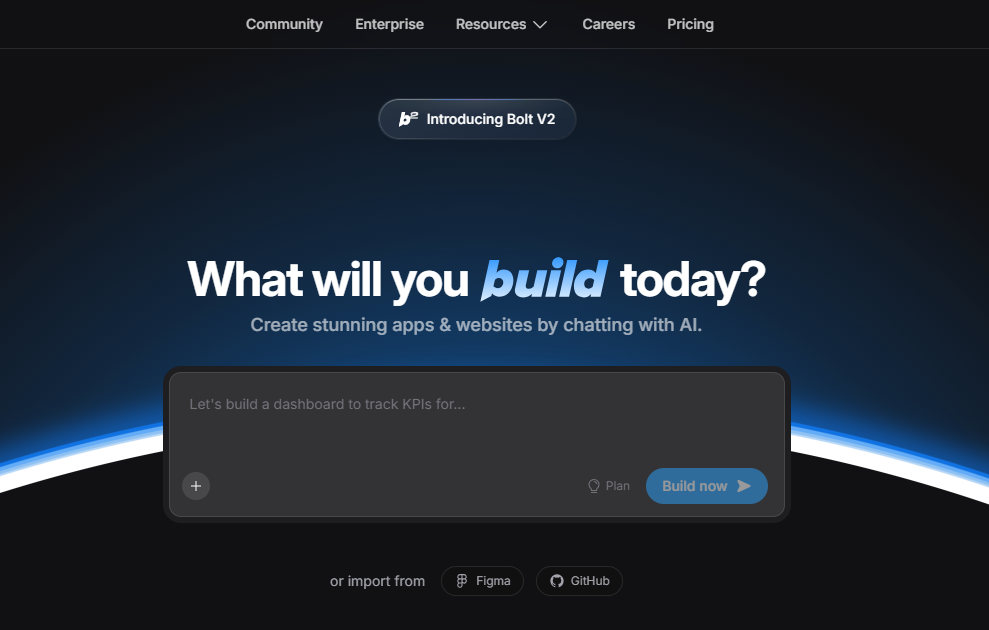Have you ever wished you could simply describe an app idea and watch it come to life before your eyes? That’s exactly the revolutionary promise that’s been making waves across the developer community.
If you’ve been hearing the buzz but find yourself wondering what is Bolt.new and whether it can truly deliver on its ambitious claims, you’re in the right place.
In this comprehensive exploration, we’re going to demystify what is Bolt.new and examine whether this browser-based AI coding assistant can truly transform how we build web applications.
What Is Bolt.new?
So, what is Bolt.new in practical terms? Imagine having a senior developer available 24/7 who can instantly scaffold complete web applications based on your descriptions. That’s the core experience Bolt.new delivers—an AI-powered, browser-based development environment that translates natural language into working, full-stack projects.

When exploring what is Bolt.new, it’s crucial to understand it’s more than just a code generator. It creates genuine, exportable applications using modern frameworks like React, Node.js, and PostgreSQL. The magic happens through WebContainers technology developed by StackBlitz, which enables a full Node.js environment to run securely directly in your browser. This eliminates the traditional setup headaches and lets you focus entirely on bringing your ideas to life.
Bolt.new Features
Bolt.new packs an impressive array of features designed to streamline the entire development process. Let’s explore the capabilities that make this platform stand out in the crowded field of AI development tools.
1. Conversational Development Interface
The heart of Bolt.new lies in its prompt-based development approach. Instead of writing code line by line, you describe what you need in plain English. The AI interprets your intent and generates appropriate, working code structures. This conversational interface makes Bolt.new particularly powerful for quickly testing ideas or building internal tools without getting bogged down in implementation details.
2. Complete Full-Stack Generation
Unlike simpler tools that might create only frontend components, Bolt.new builds complete application architectures including dynamic React frontends, Node.js backends with Express servers, database integrations, and connecting API logic. You’re getting a production-ready foundation that follows modern development best practices.
3. Browser-Based Development Environment
The zero-setup development environment represents a significant part of understanding what is Bolt.new practical value. The integrated Web-based IDE includes a file explorer, code editor with syntax highlighting, live preview pane, and functional terminal—all running directly in your browser. This eliminates environment configuration issues and enables development from any device with a modern web browser.
4. Modern Technology Stack Support
Bolt.new generates code using React, Tailwind CSS, Node.js, and PostgreSQL rather than outdated frameworks. This ensures the applications you create are maintainable, scalable, and can be seamlessly transitioned to traditional development workflows when needed.
5. Integrated Deployment and Enhancement Tools
Bolt.new provides one-click deployment to services like Vercel and Netlify, plus integration with third-party tools like Stripe and Supabase. The “Enhance Prompt” feature allows for surgical refinements without regenerating entire projects, making iterative development surprisingly efficient.
Bolt.new Pros and Cons
Like any cutting-edge tool in the rapidly evolving AI landscape, Bolt.new brings an impressive set of advantages but also comes with certain limitations that serious users should be aware of.
Bolt.new Pros
- Rapid Prototyping: This is Bolt’s superpower. You can literally go from a vague idea to a working, full-stack application capable of running and accepting data in under five minutes. This capability is invaluable for validation and iteration.
- Hybrid Workflow: It seamlessly blends AI generation with traditional manual coding. You can use the AI for the heavy lifting of setup and boilerplate, then jump in and hand-edit the code for the intricate details.
- Integrated Deployment and Sharing: One-click deployment to services like Netlify simplifies the process of making your work public. Furthermore, the share links make collaborative debugging or showing off progress effortless.
- True Zero Local Setup: The WebContainers power means no more “works on my machine” excuses. Everything happens in the browser, eliminating environment headaches, OS compatibility issues, and dependency hell.
- Error Detection and Fixing: The AI acts as a smart assistant, often suggesting intelligent fixes for common issues, which significantly speeds up the debugging cycle—a developer’s dream.
- Low Vendor Lock-in: The platform generates real, standard code. You can easily export the entire project structure and continue working locally or in a different IDE, ensuring you retain full control.
Bolt.new Cons
- The Prompt Learning Curve: Like all generative AI, the quality of the output is directly proportional to the quality of the input. Vague, low-effort prompts will inevitably produce generic or unhelpful outputs. Mastering the “AI Prompt Engineering” for code is a necessary skill.
- Performance Ceilings: While WebContainers are incredible, a browser-based environment is not a dedicated, high-spec local machine. For extremely large, monolithic projects or tasks requiring heavy, sustained computation (like video processing or intense compilation), the browser environment can still struggle.
- Complex UI Still Needs Hand-Crafting: While the AI is great at scaffolding functional apps, intricate or highly customized user interface layouts, particularly those focused on unique aesthetics, still require a designer’s touch and manual code tweaking. The AI can build the house, but you still need to handle the interior design.
- Token Consumption: Complex, large-scale code generation tasks consume computing resources (often measured in “tokens” or equivalent credits) quickly. Using the AI for constant, large-scale changes can become costly or hit usage limits faster than expected.
Who Should Use Bolt.new
The documentation and the rapidly growing community feedback suggest that Bolt.new isn’t just for one type of user; its utility spans the entire development ecosystem:
1. Experienced Developers
For seasoned coders, Bolt.new is the ultimate efficiency tool. Use it to skip all the repetitive setup and boilerplate. Need to start a quick side project with a specific stack you haven’t touched in a while? Bolt handles the grunt work. Furthermore, they can use the chat assistant for rapid, targeted code changes or to quickly prototype a database structure, and then export the clean, structured code to continue development locally in their preferred environment.
2. Founders and Product Managers
For non-technical or semi-technical founders and Product Managers, Bolt.new is a powerful validation engine. They can describe their vision and produce an interactive, clickable Minimum Viable Product (MVP) in a single afternoon. This allows them to validate market ideas, gather real user feedback, and secure investment before spending significant resources on engineering. It turns the process of getting a demo ready from weeks into hours.
3. Students and Non-Developers
For those new to coding or students exploring a new framework, Bolt.new is an incredible learning tool. They can generate a working app and then inspect the resulting code (which is clean and modern) to see how a full-stack application is structured. While some basic coding knowledge helps for customization, the platform makes it possible to build small, functional web apps just by following natural-language prompts, demystifying the whole process.
Final Words on What Is Bolt.new
So, after our deep dive, what is Bolt.new in the end? It’s not a magic bullet that replaces developers, but a powerful co-pilot that redefines the start of the development journey. Its true value lies in dramatically accelerating prototyping and making full-stack development accessible.
The platform smartly bridges the gap between AI generation and traditional coding by producing real, exportable code. This ensures you get a head start without vendor lock-in. While complex applications still need a developer’s touch, Bolt.new excels at turning a spark of an idea into a working foundation in minutes.
In short, what is Bolt.new if not a glimpse into the future of coding? It’s an essential tool for anyone looking to leverage AI for faster, more efficient web development.



